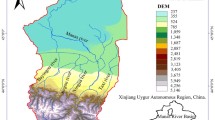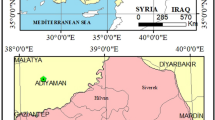Abstract
In recent decades, China has been experiencing rapid economic development, population growth and urbanization. These processes have stressed the shortages of water resources in China, especially in the arid regions of northwestern China. In order to sustain the expanding cropland, people increased groundwater exploitation in these regions. The purpose of this study was to quantitatively analyze the changes in land use and water resources, and their relationship in the middle reaches of the Heihe River Basin, a typical inland river basin in northwest China. The data of land use change were interpreted using aerial photographs (1965) and Landsat TM images (1986 and 2007). The data of irrigation water volume in the irrigation districts were spatialized in the middle reaches of the Heihe River Basin. The spatial variation of the groundwater depth was interpolated using the geostatistical method. The results showed that the cultivated cropland area along oasis fringe increased by 15.38% and 43.60% during the periods 1965–1986 and 1986–2007, respectively. Surface water amount for irrigation had almost doubled from 1956 to 2010. The decrease of grassland area mainly occurred at the alluvial fan in front of the Qilian Mountains, with 36.47% during 1965–1986 and 38.56% during 1986–2007, respectively. The groundwater depth in front of the mountain constantly increased from 1986 to 2007. We found that the overuse of surface water and overexploitation of groundwater had direct consequences on the natural environments. We suggests that the efficiency of surface water resources use among different irrigation districts needs to be improved, which will significantly ease the conflicts between increasing water demand for irrigation and a shortage of water resources in the middle reaches of the Heihe River Basin.
Similar content being viewed by others
References
Baker T J, Miller S N. 2013. Using the Soil and Water Assessment Tool (SWAT) to assess land use impact on water resources in an East African watershed. Journal of Hydrology, 486: 100–111.
Calow R C, Robins N S, MacDonald A M. 1997. Groundwater management in drought-prone areas of Africa. International Journal of Water Resources Development, 13(2): 241–262.
Chen X, Yan J F, Chen Z. 2009. A spatial geostatistical analysis of impact of land use development on groundwater resources in the Sangong Oasis Region using remote sensing imagery and data. Journal of Arid Land, 1(1): 1–8.
Chen Y N, Zilliacus H, Li W H. 2006. Ground-water level affects plant species diversity along the lower reaches of the Tarim River, Western China. Journal of Arid Environments, 66(2): 231–246.
Choi W, Deal B M. 2008. Assessing hydrological impact of potential land use change through hydrological and land use change modeling for the Kishwaukee River basin (USA). Journal of Environmental Management, 88(4): 1119–130.
DeFries R, Eshleman N K. 2004. Land-use change and hydrologic processes: a major focus for the future. Hydrological Processes, 18(11): 2183–2186.
Foley J A, DeFries R, Asner G P. 2005. Global consequences of land use. Science, 309(5734): 570–574.
Gao Q Z, Li F X. 1991. Rational Exploitation of Water Resources in the Heihe River Basin. Lanzhou: Gansu Science and Technology Press, 78–228.
Guo Q L, Yang Y S, Chen Z H. 2010. Ecological water requirements of vegetation in Ejina oasis. Journal of Water Resources & Water Engineering, 21(003): 80–84.
Hoff H. 2002. The water challenge: joint water project. Global Change Newsletter, 50: 46–48.
Houghton R A. 1994. The worldwide extent of land-use change. Bioscience, 44(5): 305–313.
Im S, Kim H, Kim C, Jang C. 2009. Assessing the impacts of land use changes on watershed hydrology using MIKE SHE. Environmental Geology, 57(1): 231–239.
Ji X B, Kang E S, Chen R S. 2006. The impact of the development of water resources on environment in arid inland river basins of Hexi region, Northwestern China. Environmental Geology, 50(6): 793–801.
Jin X M, Hu G C. 2010. Vegetation change and estimation of the smallest water demand of Ejina oasis in lower reaches of Heihe River. Advance in Science and Technology of Water Resources, 30(1): 30–34.
Lambin E F. 1997. Modelling and monitoring land-cover change processes in tropical regions. Progress in Physical Geography, 21(3): 375–393.
Lambin E F, Baulies X, Bockstael N E. 2002. Land-use and Land-cover Change Implementation Strategy, IGBP Report No. 48/IHDP Report No. 10, Stockholm: IGBP and IHDP, 65–125.
Leng C, Chen Y N, Li X G. 2011. Evaluation of oasis stability in the lower reaches of the Tarim River. Journal of Arid Land, 3(2): 123–131.
Li X, Lu L, Cheng G D. 2001. Quantifying landscape structure of the Heihe River Basin, north-west China using FRAGSTATS. Journal of Arid Environments, 48(4): 521–535.
Li X, Nan Z T, Cheng G D. 2011. Toward an improved data stewardship and service for environmental and ecological science data in West China. International Journal of Digital Earth, 4(4): 347–359.
Liu J Y, Liu M L, Tian H Q. 2005. Spatial and temporal patterns of China’s cropland during 1990–2000: An analysis based on Landsat TM data. Remote Sensing of Environment, 98(4): 442–456.
Loveland T R, Reed B C, Brown J F. 2000. Development of a global land cover characteristics database and IGBP DISCover from 1 km AVHRR data. International Journal of Remote Sensing, 21(6–7): 1303–1330.
Lu L, Li X, Cheng G D. 2003. Landscape evolution in the middle Heihe River Basin of north-west China during the last decade. Journal of Arid Environments, 53(3): 395–408.
Mellander P E, Gebrehiwot S G, Gardenas A I, et al. 2013. Summer rains and dry seasons in the Upper Blue Nile Basin: the predictability of half a century of past and future spatiotemporal patterns. Plos One, 8(7): 1932–6203.
Ozturk M, Copty N K, Saysel A K. 2013. Modeling the impact of land use change on the hydrology of a rural watershed. Journal of Hydrology, 497: 97–109.
Pielke R A, Marland G, Betts R A. 2002. The influence of land-use change and landscape dynamics on the climate system: relevance to climate-change policy beyond the radiative effect of greenhouse gases. Philosophical Transactions of the Royal Society of London. Series A: Mathematical, Physical and Engineering Sciences, 360(1797): 1705–1719.
Qi S Z, Luo F. 2006. Land-use change and its environmental impact in the Heihe River Basin, arid northwestern China. Environmental Geology, 50(4): 535–540.
Raini J A. 2009. Impact of land use changes on water resources and biodiversity of Lake Nakuru catchment basin, Kenya. African Journal of Ecology, 47(Suppl. 1): 39–45.
Scanlon B R, Reedy R C, Tachovsky J A. 2007. Semiarid unsaturated zone chloride profiles: Archives of past land use change impacts on water resources in the southern High Plains, United States. Water Resources Research, 43, W06423.
Turner M G, Pearson S M, Bolstad P. 2003. Effects of land-cover change on spatial pattern of forest communities in the Southern Appalachian Mountains (USA). Landscape Ecology, 18(5): 449–464.
Wagner P D, Kumar S, Schneider K. 2013. An assessment of land use change impacts on the water resources of the Mula and Mutha Rivers catchment upstream of Pune, India. Hydrology and Earth System Sciences, 17(6): 2233–2246.
Wang G X. 1997. Analysis of rational utilization of water resources in Eijina green district of Heihe River, Nei Mongol. Journal of Lanzhou University: Natural Sciences, 33(3): 111–116.
Wang G X, Cheng G D. 2000. The characteristics of water resources and the changes of the hydrological process and environment in the arid zone of northwest China. Environmental Geology, 39(7): 783–790.
Wang G X, Cheng G D, Shen Y P. 2002. Dynamic tendency of arid oasis under the influence of water resources decrease-a case study of Ejina oasis in Heihe River Basin. Chinese Journal of Applied Ecology, 13(5): 564–568.
Wang G X, Liu J Q, Kubota J. 2007. Effects of land-use changes on hydrological processes in the middle basin of the Heihe River, northwest China. Hydrological Processes, 21(10): 1370–1382.
Wang G X, Yang L Y, Chen L. 2005. Impacts of land use changes on groundwater resources in the Heihe River Basin. Journal of Geographical Sciences, 15(4): 405–414.
Wang G X, Zhou J, Kubota J. 2008. Evaluation of groundwater dynamic regime with groundwater depth evaluation indexes. Water Environment Research, 80(6): 547–560.
Wang J H, Hu X L. 2007. Research on Land Use and Land Cover Change of Zhangye City in 2007. Lanzhou: Cold and Arid Regions Environmental and Engineering Research Institute, 1–60.
Wang Y M, Yan C Z, Wang J H. 1986. Land Use Map of the Heihe River Basin in 1986. Lanzhou: Cold and Arid Regions Environmental and Engineering Research Institute.
Zhang Y C, Yu J J, Qiao M Y. 2011. Effects of eco-water transfer on changes of vegetation in the lower Heihe River basin. Journal of Hydraulic Engineering, 7(7): 757–765.
Zhao R F, Chen Y N, Shi P J. 2013. Land use and land cover change and driving mechanism in the arid inland river basin: a case study of Tarim River, Xinjiang, China. Environmental Earth Sciences, 68(2): 591–604.
Zhao W Z, Chang X L, He Z B. 2007. Study on vegetation ecological water requirement in Ejina Oasis. Science in China Series D: Earth Sciences, 50(1): 121–129.
Zhou J, Hu B X, Cheng G D, et al. 2011. Development of a three-dimensional watershed modelling system for water cycle in the middle part of the Heihe rivershed, in the west of China. Hydrological Processes, 25(12): 1964–1978.
Author information
Authors and Affiliations
Corresponding author
Rights and permissions
About this article
Cite this article
Nian, Y., Li, X., Zhou, J. et al. Impact of land use change on water resource allocation in the middle reaches of the Heihe River Basin in northwestern China. J. Arid Land 6, 273–286 (2014). https://doi.org/10.1007/s40333-013-0209-4
Received:
Revised:
Accepted:
Published:
Issue Date:
DOI: https://doi.org/10.1007/s40333-013-0209-4




